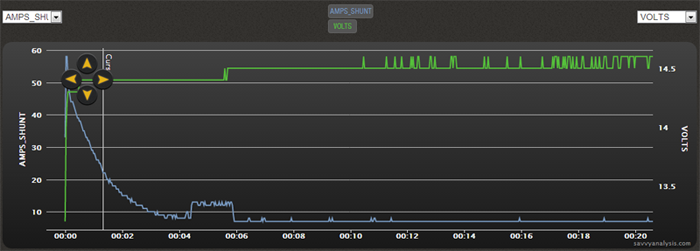Having experienced my second PC680 failure today, my airplane is now on it's 3rd battery in 12 months.
Both failures were identical: the battery was working perfectly, and then the next time I pulled the plane out, it refused to start. The battery would pull a couple blades through, then click-click-click on the solenoid. Putting the approved Odyssey charger (6Amp) on the battery, it ran right up to "charged" on about 10 seconds.
When the original battery failed, I wrote it off as a leftover injury from several "oops, left the power on" episodes during building, which ran the battery completely dead. With this second identical failure, I'm wondering if there isn't something else at work.
I've read the previous big thread on this failure mode, which ended up focusing on a pattern of charger use that I don't follow. This battery has never seen the charger, only charged by the alternator after start. My PP alternator holds the bus voltage at 14.6 volts, which is in line with Odyssey's recommendation for 14.5+. Review of data logs show nothing unusual in amps or volts readings from the previous flights. (Previous flight was 6 days earlier.)
The displayed voltage on the bus prior to a start attempt was 12.6V, and it drops to 8.4V during start, when the solenoid drops out. I took the battery for a load test at Batteries Plus, who said it was giving less than 50% of it's rated output. This battery was installed 30 Hobbs hours ago, in March '13. The master switch completely disconnects the battery -- there are no parasitic/keep-alive loads.
I came home with a new battery, which I'll install tomorrow, and I expect everything will operate normally as it did before. Given the sudden and warning-less nature of the failure, it sure would be ideal to have an explanation other than "it happens." Heat? Vibration? The mounting is Van's box, installed per plans.
Both failures were identical: the battery was working perfectly, and then the next time I pulled the plane out, it refused to start. The battery would pull a couple blades through, then click-click-click on the solenoid. Putting the approved Odyssey charger (6Amp) on the battery, it ran right up to "charged" on about 10 seconds.
When the original battery failed, I wrote it off as a leftover injury from several "oops, left the power on" episodes during building, which ran the battery completely dead. With this second identical failure, I'm wondering if there isn't something else at work.
I've read the previous big thread on this failure mode, which ended up focusing on a pattern of charger use that I don't follow. This battery has never seen the charger, only charged by the alternator after start. My PP alternator holds the bus voltage at 14.6 volts, which is in line with Odyssey's recommendation for 14.5+. Review of data logs show nothing unusual in amps or volts readings from the previous flights. (Previous flight was 6 days earlier.)
The displayed voltage on the bus prior to a start attempt was 12.6V, and it drops to 8.4V during start, when the solenoid drops out. I took the battery for a load test at Batteries Plus, who said it was giving less than 50% of it's rated output. This battery was installed 30 Hobbs hours ago, in March '13. The master switch completely disconnects the battery -- there are no parasitic/keep-alive loads.
I came home with a new battery, which I'll install tomorrow, and I expect everything will operate normally as it did before. Given the sudden and warning-less nature of the failure, it sure would be ideal to have an explanation other than "it happens." Heat? Vibration? The mounting is Van's box, installed per plans.





